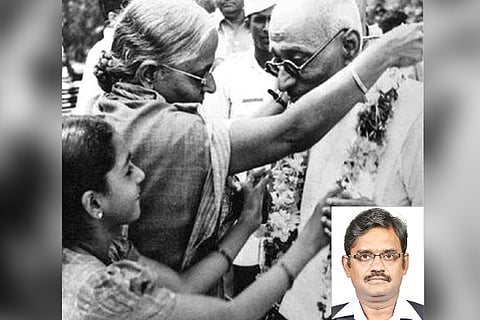

Chennai
IN 10 years, India would be free.
But no one knew that at that point in time. In 1937, in a rare gesture, the British government would allow its arch-enemy — the Congress — to form governments in the presidencies. This short-lived experiment provided either side with valuable insights into the working methods of each other.
The Justice Party was in power in Madras, but that was no advantage. On the contrary, it had become highly disliked, led by a zamindar, the Raja of Bobbili. An economic depression was affecting Madras. While they could not manage it, the Raja’s ministers were leading ostentatious lifestyles. They voted to pay themselves more than Rs 4,000 salary.
The Justice Party was divided with factionalism and the Raja was not accessible to most of his ministers even, let alone the common man. The joke that made the rounds was that the party had more leaders than followers.
The Congress on the other hand was rejuvenated by its Salt Satyagraha and other agitations. It now had a sense of purpose. But what strengthened the Congress was the merger of its erstwhile colleagues, the Swarajists.
The Congress had kept off all elections from 1921, questioning the legitimacy of the British government in conducting them. A group of Congressmen believed that elections had to be contested and broke away, forming the Swaraj Party. Though they won a majority in Madras once, they did not form the government in accordance with the wishes of the parental party. To them, it was training for their leaders of the future as well as a warning to the British, constantly showing their strength. The Swaraj Party merged with the Indian National Congress in 1935 when the Congress decided to contest elections.
The Congress mobilised popular opposition against the Justice Party government with seasoned campaigners who could swing votes to their side and a manifesto highly populist. Reduced land taxes, better working conditions and higher wages for the labourers were promised. Most of all, it appealed to the nationalist sentiment of the populace.
Winning this election was one step away from attaining freedom, the people were made to believe.
The Justice Party, on the other hand, had a rather ambiguous manifesto. It was still talking about caste and Brahmin domination. The people’s focus had long shifted to economics with the great interwar depression.
For the first time, the Congress faction led by Sathyamurthi used the upcoming cinema stars as campaigners. Chittor V Nagaiah and KB Sundarambal toured the Andhra and Tamil provinces extensively. Sundarambal would record multiple gramophone records in support of the Congress.
The Congress for the first time in the history of India would have Srinivasa Cinetone produce a campaign film directed by A Narayanan. When it featured the speeches of Congress leaders, realising its possible reach, the British government would restrict its screening.
The slogan ‘Vote for Gandhi’ was very catchy and the Congress obtained a majority by winning 159 of 215 seats in the Legislative Assembly.
Many Justice Party candidates, seeing the writing on the wall, withdrew and Congressmen like Kamaraj were elected unopposed. Rajaji won from the graduates’ constituency. Most Justice Party candidates forfeited their deposits.
Chief Minister Raja of Bobbili was defeated by VV Giri, who would later become President, in Bobbili’s home constituency itself.
The victory in Madras was the Congress’s most notable electoral feat in all the provinces of British India. They fared poorly in Bengal and Punjab.
Despite winning, Congress was hesitant to form a government. Its objections were to the special controls given to the Governor whose absolute discretionary powers could overrule the Cabinet.
Madras Governor Erskine formed a government with non-members and the opposition. This was fast becoming a farce and after 100 days the British government convinced Congress to take over with assurances.
Rajaji formed the government.
Rajaji ministry did raise some eyebrows. Sathyamurthy, who should have been the leader and had diplomatically stepped aside, was not even given a minister post.
Rajaji first cut the salary of ministers from Rs 4,400 to 500. Other than that, Rajaji seemed a man in a hurry. In the first month, he released a substantial number of political prisoners from jail. In the second month, it was Gandhi’s pet scheme of prohibition. Some bootleggers were shot mercilessly. Except for Europeans, many could not drink in certain districts.
Debt relief and waiver of payments due to zamindars also happened.
To increase revenue Rajaji also taxed electricity, fuel, cinema and brought in the general sales tax act (first time in Asia).
Rajaji quietly removed the controversial Mount Road statue of the “butcher of Allahabad” Col Neill and shifted to the museum, perhaps the only such incident when a British statue was removed during their rule.
However, the Rajaji government is remembered in history for its most controversial decision — the Hindi imposition in some schools. Rajaji likened it to chutney on the plate. “Take it or leave it.”
But the Presidency erupted in protests. Rajaji found it convenient to use the riot control laws which the British had used on him a few months earlier.
Protestors died.
The Congress government lasted till October 1939, when it resigned protesting India’s involvement in the Second World War.
The first term of Rajaji was a great experiment where the ruler and the ruled cooperated in the interest of the nation.
The after-effects of some of its decisions are still felt today.
— The writer is a historian and an author
Visit news.dtnext.in to explore our interactive epaper!
Download the DT Next app for more exciting features!
Click here for iOS
Click here for Android